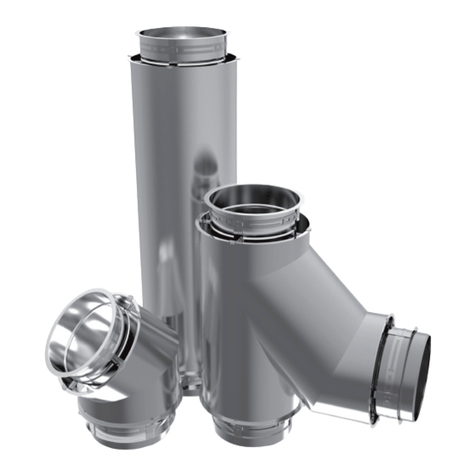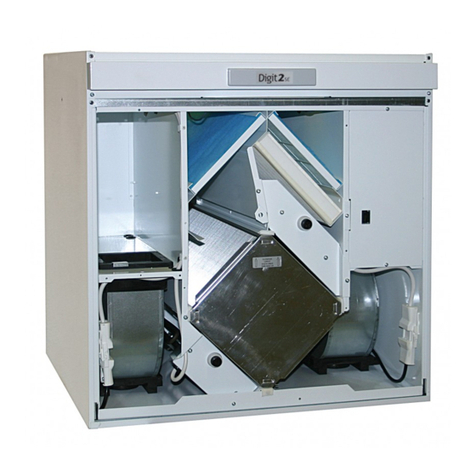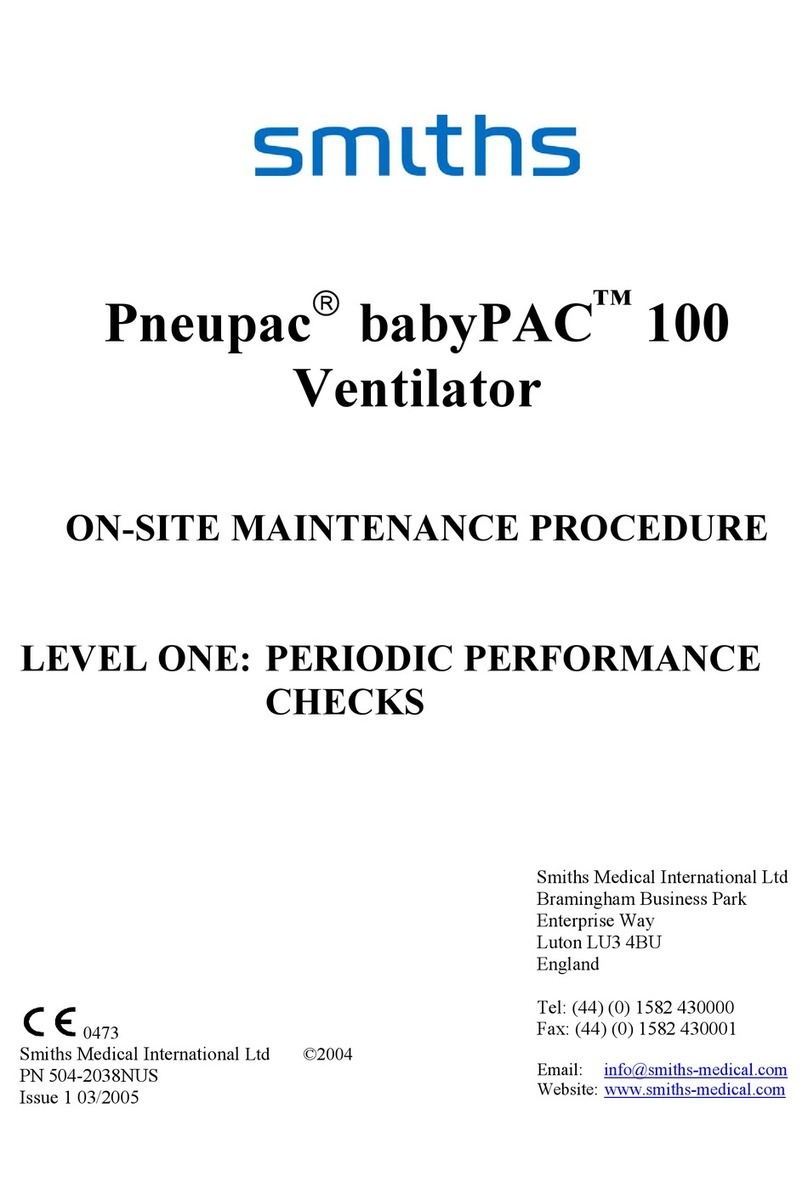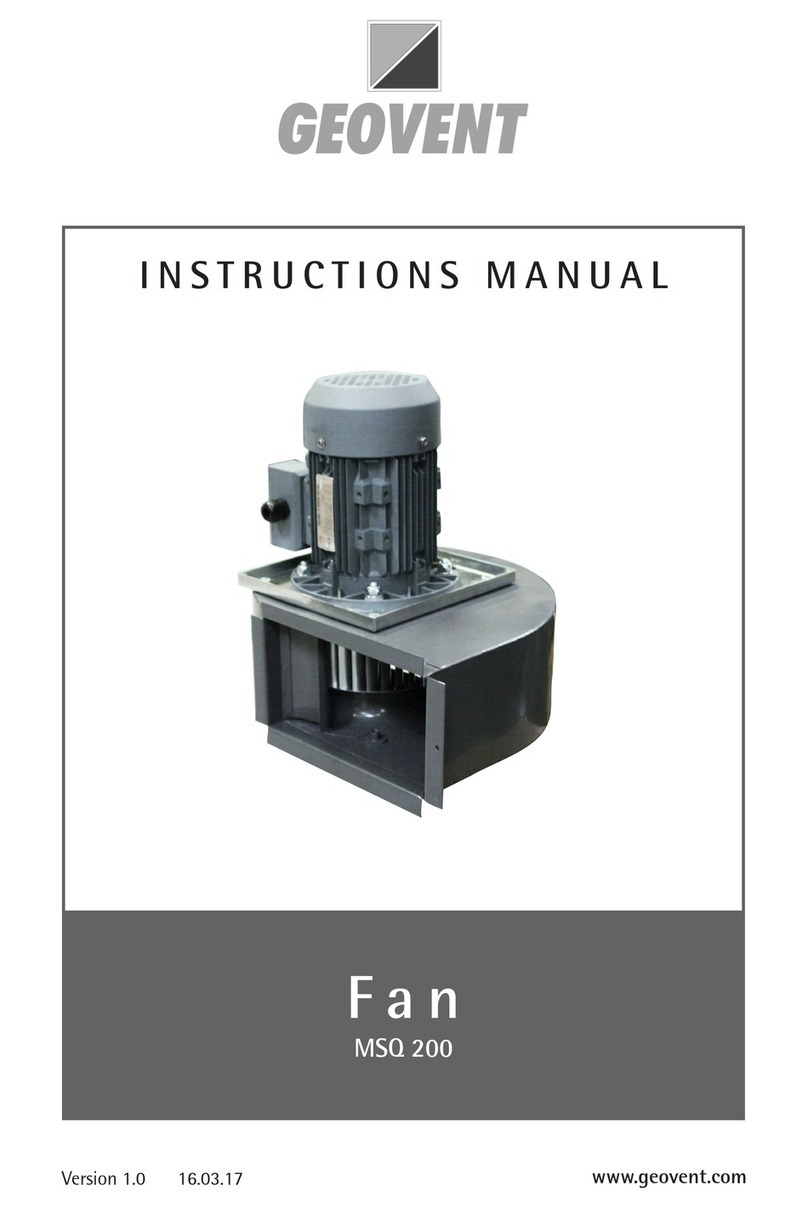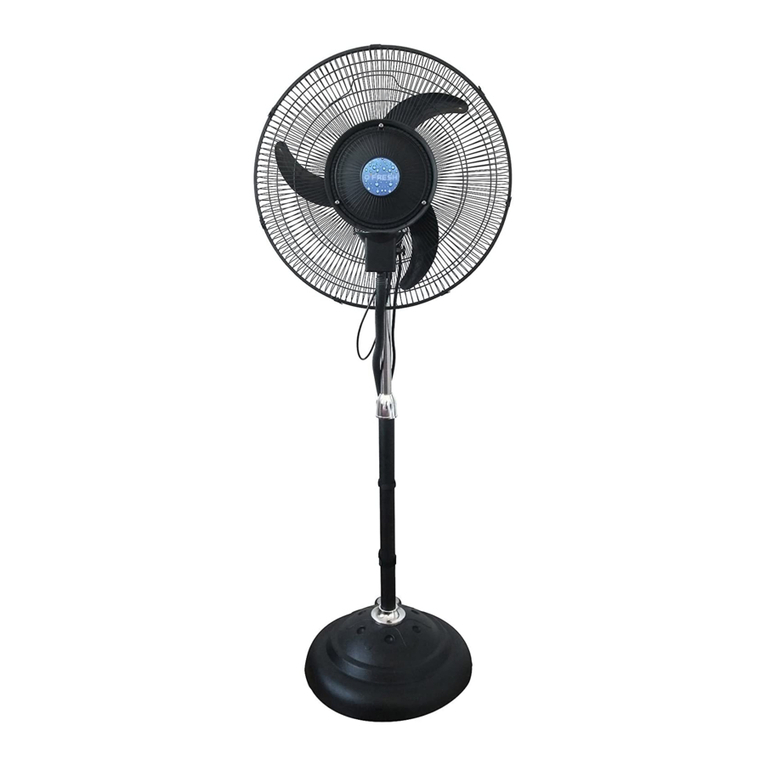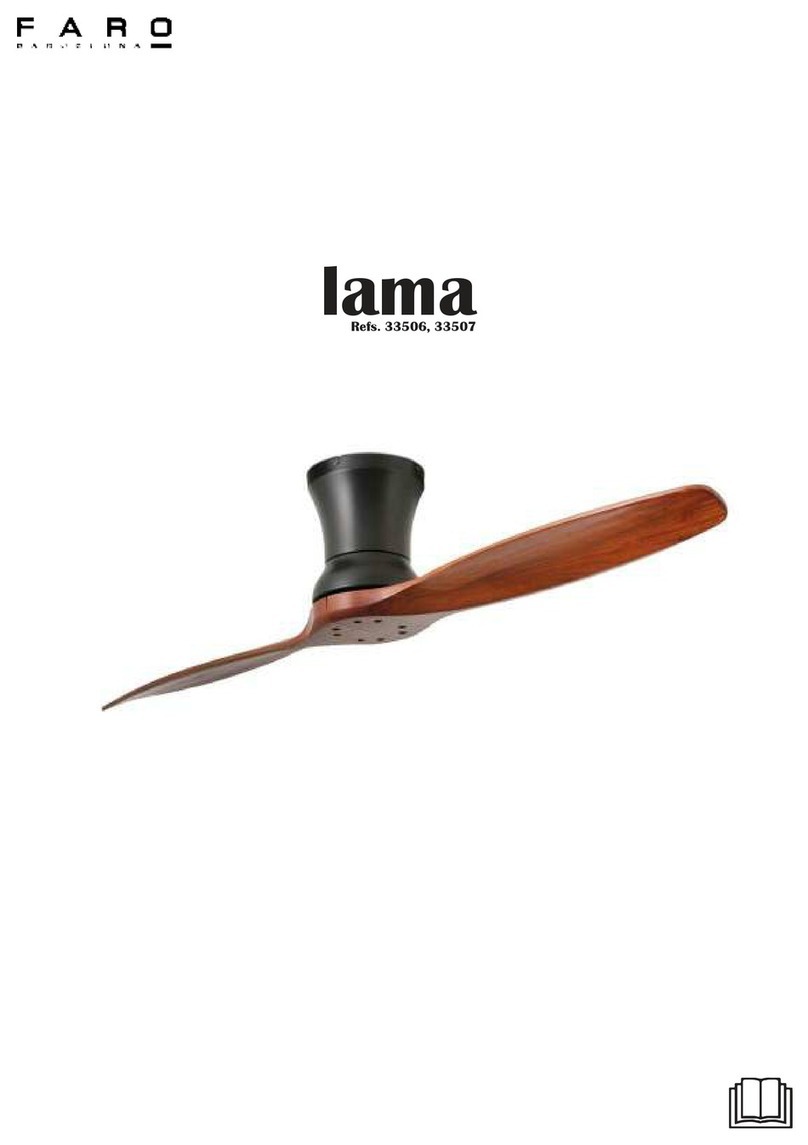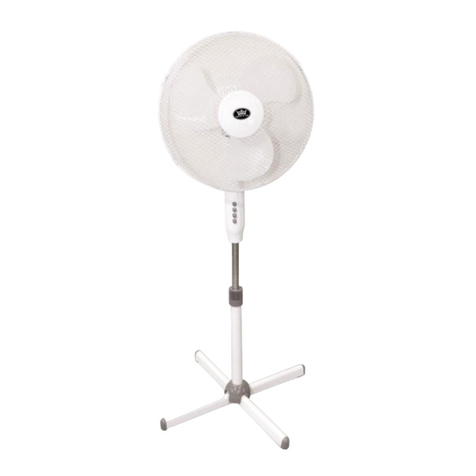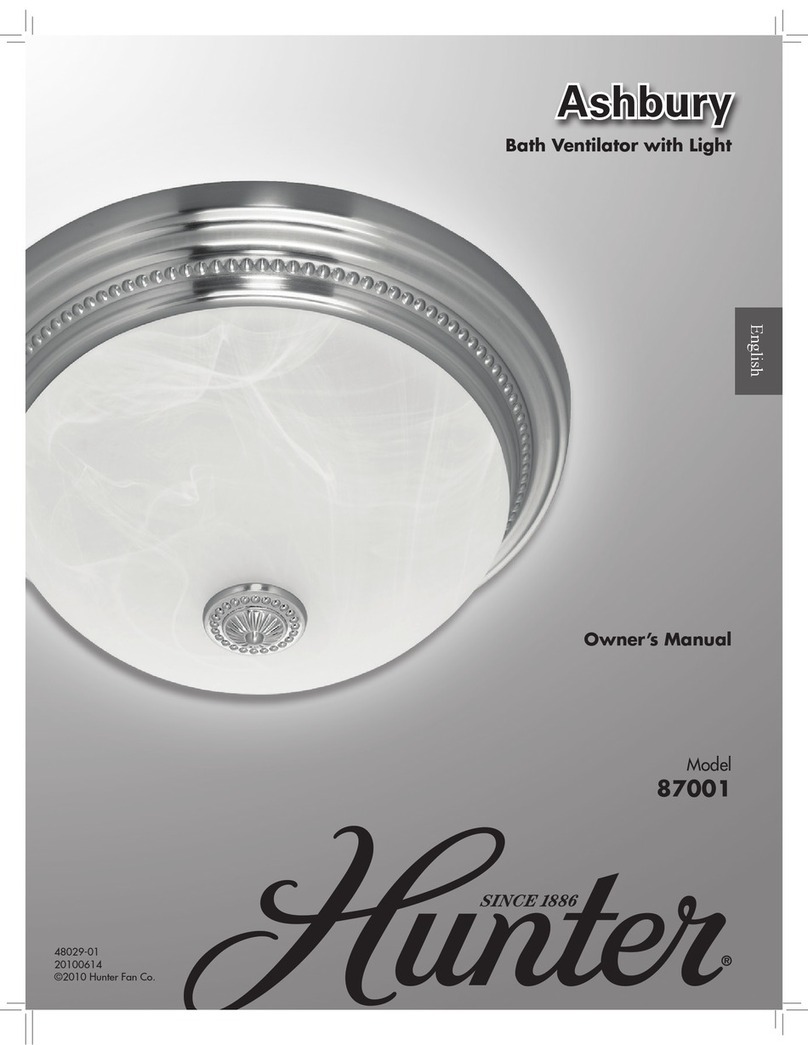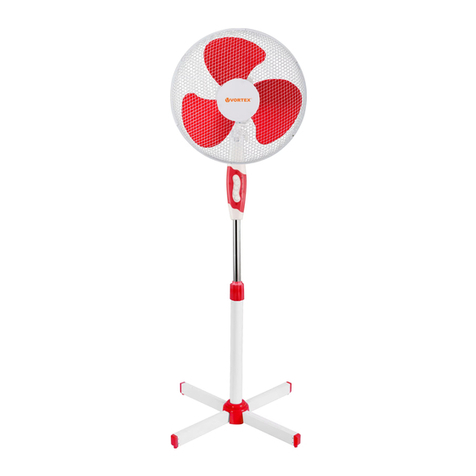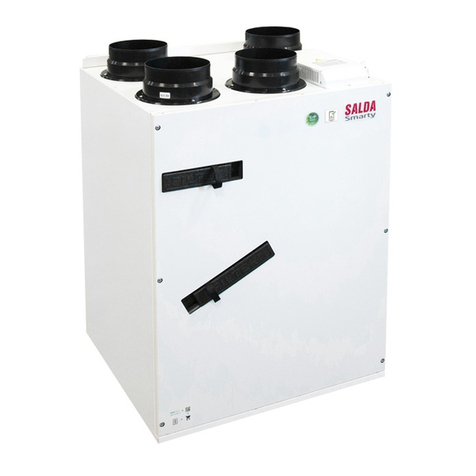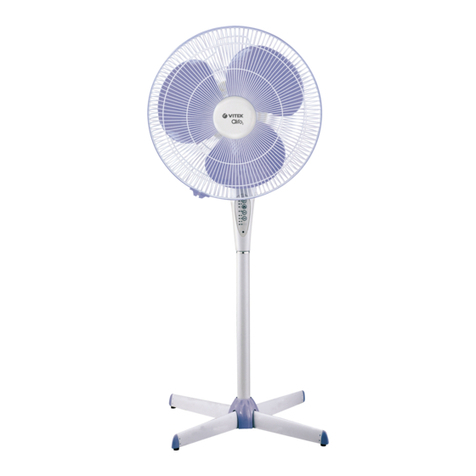Security Chimneys secure pellet User manual

Secure Pellet ®
Venting System for Pellet, Corn, Oil,
and Biofuel appliances.
Installation Instructions

A MAJOR CAUSE OF VENT RELATED FIRES IS FAILURE
TO MAINTAIN REQUIRED CLEARANCES (AIR SPACES) TO
COMBUSTIBLE MATERIALS. IT IS OF THE UTMOST IMPORTANCE
THAT DOUBLE WALL SECURE PELLET BE INSTALLED ONLY IN
ACCORDANCE WITH THESE INSTRUCTIONS.
NOTE:
Read through all of these instructions before
beginning your installation. Failure to install
as described in this instruction will void the
manufacturer’s warranty, and may have an
effect on your homeowner’s insurance and
UL listing status. Keep these instructions for
future reference. This booklet also contains
instructions for installing a venting system
within an existing masonry chimney, and
for installations passing through a cathedral
ceiling.
LISTED
MH25317

3
Secure Pellet ®
CONTENTS
Clearances, Vent Listing, Installation Notes, Lubricants & Gaskets . . . . 4
Sealants, Fuel Selection, Best Practices . . . . . . . . . . . . . . . . . . . . . . . . . . . 5
Tools Needed, Permits, General Installation Instructions . . . . . . . . . . . . . . .6
Installation into Masonry Fireplaces . . . . . . . . . . . . . . . . . . . . . . . . . . . . . . 15
Installation Through Side of Masonry Chimney . . . . . . . . . . . . . . . . . . . . . .17
Installation in a Cathedral Ceiling . . . . . . . . . . . . . . . . . . . . . . . . . . . . . . . . . 18
Cleaning and Maintenance .. . . . . . . . . . . . . . . . . . . . . . . . . . . . . . . . . . . . . 21
VENTING SYSTEM FOR PELLET, CORN, OIL, AND BIOFUEL APPLIANCES.

4
CLEARANCES AND APPLICATIONS
Security Chimney's Secure Pellet is listed by
Underwriters Laboratories as vent for listed
appliances that burn oil, pellet, corn, and other
biofuels. Secure Pellet is also listed as a
masonry reliner with the minimum clearance 0”
from vent to masonry, and 0” clearance from
the masonry to nearby combustibles. Never ll
any required clearance space with insulation
or any other materials (except insulation
explicitly approved by Security as noted
below). Combustible materials include (but
are not limited to) lumber, plywood, sheetrock,
plaster and lath, furniture, curtains, electrical
wiring, and building insulation except that
noted below.
In the United States and Canada the minimum
clearance to combustibles from Secure
Pellet is 1” for oil, pellet, corn or other biofuel
applications.
NON-COMBUSTIBLE INSULATION
Security Chimney approves the eld
application of non-combustilble insulation
within the clearance to combustible distance
(in wall thimbles or support boxes only) if/when
desirable. Approved insulation must be listed
/ compliant with ASTM E136/ULC S114 as
Non-Combustible, have a melting temperature
above 2000°F/1100°C, be water resistant with
low moisture absorbtion and be acceptable to
the AHJ. Materials would include those made
from stone (aka “rockwool” or “mineral wool”
insulations). NOTE- Fiberglass insulation is
NOT approved!
VENT LISTING
Secure Pellet is listed by Underwriters
Laboratories to UL 641 Type L Low
Temperature Venting Systems, ULC S609
Low Temperature Vents, and ULC/ORD-C441
Standard for Pellet Vents .
INSTALLATION NOTES
Proper planning for your Secure Pellet
installation will result in greater safety,
efciency, and convenience, saving both time
and money. Use only authorized Security
Chimney and DuraVent listed parts. Do not
install damaged parts.
1. WARNING: When passing through ceilings
and walls, make sure all combustible materials
and combustible building insulation products
are a minimum of 1” from the vent pipe
2. For horizontal terminations, make sure
NFPA 211 rules are followed for minimum
distance from windows and openings.
3. Do not mix and match with other
manufacturer’s products or improvised
solutions.
4. Practice good workmanship. Sloppy
work could jeopardize your Secure Pellet
installation.
5. Never use a vent with an inside diameter
that is smaller than the appliance ue outlet.
6. Multistory: Where Secure Pellet passes
through the ceiling, use Security Chimney's
Firestop/Support assembly.
7. Vent placement: When deciding the
location of your stove and vent, try to minimize
the alteration and reframing of structural
components of the building.
8. Sections of pipe are connected to each
other by pushing them rmly together and
twisting. Screws are not required. However, if
screws are desired, use 1/4”-long sheet metal
screws. Important! Do not penetrate the inner
liner with screws.
9. Never install single-wall pipe to freestanding
pellet stoves. Single-wall pipe may be
connected to a replace insert, provided it

5
is inside the replace, and the replace has
completely sealed surroundings.
10. Do not connect Type B Gas Vent pipe with
aluminum liners to pellet appliances.
LUBRICANTS & GASKETS
Secure Pellet utilizes an internal O-ring
gasket on the outside of the inner liner in the
female end of the Pipe Section. Depending on
production date, these gaskets may be factory
lubricated or eld lubricated with soapy water
/ anti-seize. If your O-ring gasket is missing
or it becomes damaged during connection,
you must replace and lubricate the new O-ring
gasket.
SEALANTS
Secure Pellet does not require additional
sealant to be used at pipe joints, but in certain
circumstances sealant may be used if desired.
Seal the inner liner overlap at the male end of
pipe for best results (Figure 6)
Note: 500ºF RTV silicone sealant is required
on the following component connections:
• Connecting certain Appliance
Adapters or other non-gasketed
parts to the appliance outlet
• When using the Adjustable Length
section.
FUEL SELECTION, BEST
PRACTICES
Secure Pellet is a multi-fuel venting
system approved for burning wood
pellets, corn, and other approved biofuels,
plus, oil and kerosene. Be sure to follow
the recommendations of the appliance
manufacturer for the burning of corn or other
types of biofuel. A major reason for accelerated
vent corrosion from burning corn is due to
acidic condensate forming in the system.
The moisture content of corn contributes
signicantly to condensate in the vent. The
lower the moisture content of the corn, the less
condensate you are likely to have in the vent.
While corn with a moisture content of 15%
may be allowed in the appliance, using a fuel
with lower moisture content will help reduce
condensate formation.
Vent Runs: Condensate is more likely to
form in longer vents because the exhaust
temperature cools further away from the
appliance. If the exhaust cools to a certain
point, moisture in the exhaust condenses
in the vent, which can lead to accelerated
vent corrosion. Keep the vent for corn-
burning appliances short wherever possible
to maintain hot ue gas temperatures and
keep moisture suspended in the exhaust. If a
longer horizontal vent or taller vertical vent is
needed, it is recommended that the vent run
inside the building envelope or inside a chase
enclosure to minimize the vent’s exposure to
cold temperatures. When terminating a corn
burning system horizontally a stainless steel
outer Pipe Section and the Round Horizontal
Termination Cap are required. Be sure to
follow all other applicable building codes
and maintain all minimum clearances in
enclosures.
Appliance Operation: Regardless of the fuel
you choose always operate your appliance in
accordance with the appliance manufacturer’s
recommendations. If you burn corn, operating
the appliance at its lowest setting has a greater
chance for condensate to form in the vent due
to the low exhaust temperature. In order to
help reduce condensate from forming inside
the vent system, operate the appliance at
higher temperatures when colder weather is

6
Figure 1
encountered. Higher operation settings provide
for warmer ue temperatures, which help to
keep moisture suspended in the ue gases.
Inspection and Maintenance: When burning
corn, be sure to inspect the appliance and
vent often to determine if there has been any
corrosion or damage to the system. Be sure
to keep the venting system clean, including
the tee cap (if applicable). The ash that results
from burning corn can trap condensate in
the tee cap and inside the vent, hastening
corrosion to the system if left unchecked.
Using pelletized fuel does not eliminate the
need for inspection and cleaning. Lesser
quality pellets create more soot accumulation
and can clog venting sooner than the cleaner
burning pellets. While it is not necessary to
clean out liquid fuel burning systems with a
brush, all other systems should be visually
inspected monthly during the heating season,
and cleaned at least once a year
TOOLS AND EQUIPMENT YOU
MAY NEED
Eye Protection
Gloves
Screwdriver
Hammer
High-Temperature Waterproof (RTV) Sealant
Tape Measure
Saber or Keyhole Saw
Level and Plumb bob
PERMITS
Contact your local building department or
re ofcials regarding any needed permits,
restrictions, and installation inspection
requirements in your area.
SECURE PELLET
PIPE
GENERAL INSTALLATION
INSTRUCTIONS
Secure Pellet is listed with a minimum 1”
clearance to combustibles
1. Follow the stove/appliance manufacturer’s
instructions.
A. Choose an appliance that is listed by a
recognized testing laboratory.
B. Connect only one ue per appliance.
C. Only burn fuels approved for use by your
appliance manufacturer.
D. Follow the appliance manufacturer’s
instructions and safety manual for maximum
efciency and safety. Over ring can damage

7
Figure 2
Figure 3
the appliance and vent.
2. If the vent exit is on top of the stove
(Figure 1):
A. Place the appliance according to the
manufacturer’s instructions.
B. Drop a plumb bob to the center of the
appliance ue outlet and mark center point on
the ceiling (Figure 2). At your marked center
point, cut and frame a square hole in the
ceiling for installation of the Ceiling Support or
Firestop Spacer (Figure 3). Refer to Table 1
for the dimensions of the hole.
SECURE PELLET
COMPONENT FRAMING DIMENSIONS
3" & 4" CEILING SUPPORT /
FIRESTOP SPACER 7 ¼”X 7 ¼”
3" & 4" CATHEDRAL CEILING
SUPPORT BOX 10 ¾" X 10 ¾"
3" & 4" WALL THIMBLE
3" & 4" CAS WALL THIMBLE 7 ¼”X 7 ¼”
3" & 4" WALL THIMBLE AIR
INTAKE KIT 11" X 11"
Table 1

8
Figure 6 Figure 7
Figure 4 Figure 5
CUT AWAY 1” MIN.
CLEARANCE TO
COMBUSTIBLES

9
Figure 8
C. Connect Pipe Adapter or Increaser Adapter
to stove: Due to the variety of different stove
collars, the Pipe Adapter will need high-
temperature non-hardening sealant in order to
achieve a leak-free connection. .
D. Connect Pipe Sections. Attach Secure
Pellet Pipe Sections by pushing male and
female ends of pipe together and twisting until
pipe is in locked position (Figure 4). Pipe
sections do not require any sealant; however
in certain instances high temp silicone sealant
may be used. Seal connection where the
inner liners overlap for best results (Figure 5).
Screws are not needed, but 1/4” screws can
be used if desired, however, be sure you do
not penetrate the inner liner.
E. When the pipe passes through the Ceiling
Support Firestop Spacer at ceiling, tighten
bolt and clamp around pipe. Where the vent
passes through additional oors and ceilings,
always install a Ceiling Support Firestop
Spacer.
F. ALWAYS MAINTAIN AT LEAST 1”
CLEARANCE FROM COMBUSTIBLE
MATERIALS TO THE VENT PIPE.
G. When the Vent enters the attic, install an
Attic Insulation Shield around the vent (Figure
6). This will prevent insulation and debris
from collecting near the vent pipe. Use (4)
nails or wood screws to secure the base of the
Attic Insulation Shield to the framed opening.
Adjust the height of the Attic Insulation Shield
by sliding the top cylindrical shield over the
one from the base. Ensure that the top of the
Shield is above the level of building insulation.
Secure the Shield in place with at least two
(2) sheet metal screws through the side of the
cylindrical shield. Attach collar around pipe,
then lower to the top of the Attic Insulation
shield.
H. After lining up for the hole in roof, using
the same method as 2. (B), cut either a round
or square hole in the roof (Figure 7). Always
cut the hole with the proper clearance to the
vent pipe. Install the upper edge and sides
of Flashing under the roong materials and
nail to the roof along the upper edge and
sides (Figure 8). Do not nail across the lower
edge. Seal all nail heads with non-hardening
waterproof sealant.
I. To nish, apply non-hardening waterproof
sealant where the Storm Collar will meet the
vent and Flashing; slide Storm Collar down
until it rests upon the Roof Flashing (Figure 9).
Holding the base of Cap, rmly twist lock your
Vertical Termination Cap onto supported Pipe
Section protruding through the roof line.
Figure 9

10
Figure 10
Figure 11
3. If the ue exits on back of stove and an
interior installation is desired (Figure 10):
A. Place the appliance according to the
manufacturer’s instructions.
B. Connect the Tee Adapter or combine Tee
with Cleanout and Pipe Adapter then seal and
secure the Pipe Adapter to the back of the
stove.
C. Continue to assemble Pipe Sections as
described in Step 2.
4. If the ue exit is on the back of stove, and
an exterior vertical installation or partial vertical
installation is desired (Figure 11):
A. Place the appliance according to
manufacturer’s instructions.
B. Cut and frame a square opening in the
wall as specied in Table 1. Secure Pellet can
be installed with the standard Wall Thimble
or Wall Thimble Air Intake Kit for through the
wall installations. The Wall Thimble Air Intake
Kit allows combustion air to be drawn through
the framed Thimble opening, eliminating the
need to cut another opening in wall. The small
ex provided with this kit allows connection
to the Pellet Stove combustion air inlet. Note
that when installing the Wall Thimble Air
Intake Kit, the pipe will not be centered within
the framed opening. Loosely assemble both
halves of the Wall Thimble onto Pipe Section.
Connect the exible hose with clamp to the
exterior half of the Wall Thimble. Guide the
ex through the opening in black interior half
of Wall Thimble, gently pull the ex towards
appliance (Figure 12), and if necessary trim
SECURE PELLET
PIPE

11
Figure 12
Figure 13
Figure 14
excess ex to required length with snips.
Secure ex to combustion air inlet of the stove
with clamp provided. Only connect metal ex
to the appliance; do not substitute or install
plastic ex. The cover plate comes installed
on the lower left corner of the thimble with
intake guard pointing downward to deect
rain. If it is desired to rotate thimble and air
inlet to another corner, remove the (2) screws
on the inlet guard and re-attach over air inlet
at new location. Secure black interior half of
the Wall Thimble to the interior wall, and the
unpainted exterior half are to be secured to the
exterior wall on both styles of thimbles (Figure
13). The Wall Thimbles adjust to t walls from
4”-8” thick. For installation in thicker walls an
extension tube may be eld fabricated.
WARNING: Do NOT install any combustible
insulation or other combustible material not
approved by Security Chimney within the
Wall Thimble itself. Doing so can create
a re hazard. The Wall Thimble ensures
the clearance to combustible material is
maintained to make a safe installation. Non-
Combustible insulation (as dened earlier in
this text) may be installed within the thimble

12
Figure 16
Figure 15
and clearance to combustible distance if
desired. Note: Fiberglass insulation is NOT
APPROVED.
C. Connect a Pipe Adapter and Pipe Section
together then seal connection to rear exhaust
outlet. Attach a Single Tee with Clean out
adapter or a Double Tee with Clean-Out
Adapter, and proceed attaching Pipe Sections
up the wall. Installing a Double Tee with
Cleanout Adapter on the exterior of wall, allows
brushing of the Horizontal Vent run through to
appliance (Figure 14).
D. Attach Wall Strap just above the tee. Wall
Straps must be placed every 8-feet along
an exterior vertical run (Figure 15). If your
exterior vertical run terminates horizontally
before penetrating the rooine, install at least
one Wall Strap on the Pipe Section before 90
Degree Elbow and Horizontal Cap (Figure 16).
Under no circumstances can a Vertical Cap
be installed adjacent to vertical wall. Secure
Pellet offers xed and Adjustable Wall Straps
to maintain a 1”-3” clearance, as desired. If
Assemble Pipe Sections in the same manner
described in Step 2 of the general instructions.
E. Seal the exterior section of the Wall
Thimble to the wall with non-hardening
waterproof sealant. As an option, you may
also seal the gap between the pipe and Wall
Thimble with sealant.
5. If the ue exit is on back of the stove, and
a horizontal through-the-wall installation is
desired (Figure 13):
A. Place the appliance according to
manufacturer’s instructions.
B. Connect the Appliance Adapter and
sufcient Pipe Sections, seal and secure to
back of stove. Horizontal Pipe sections must
penetrate Wall Thimble and extend at least 6”
beyond the exterior wall after Horizontal Cap

13
Figure 17
is attached. If you are burning Corn you must
use a Round Horizontal Cap. Pipe Sections
exposed to exhaust gases between wall and
Cap must have a Stainless Steel outer liner.
The Round Horizontal Cap can be swiveled to
be directed away from nearby objects (fence,
plants, etc.), but must still be pointing in a
generally downward direction. Important:
Horizontal Caps must be pointed in a
downward direction to insure rain and snow do
not enter the cap, and cause potential damage
to the appliance.
C. Follow the below listed NFPA 211 rule for
distance of exit terminal from windows and
openings:
NFPA 211 (2006 ed.) Section 10.4 Termination:
10.4.5
(1) The exit terminal of a mechanical draft
system other than a direct vent appliance
(sealed combustion system appliance) shall be
located in accordance with the following:
(a) Not less than 3 ft (.91m) above any forced
air inlet located within 10 ft. (3m).
(b) Not less than 4 ft. (1.2m) below, 4 ft.
(1.2m) horizontally from or 1 ft. (305mm)
above any door, window or gravity air inlet
into any building
(c) Not less than 2 ft. (0.61m) from an
adjacent building and not less than 7
ft. (2.1m) above grade when located
adjacent to public walkways.
If using the Wall Thimble Air Intake Kit, the
installation may be considered a direct vent
system, as dened by NFPA 211. Check with
local building ofcials for clarication. If so, the
clearances for the exit terminal are as follows:
For an appliance with an input of 10,000 Btu/h
(2930 W) or less, the vent terminal shall be
located at least 6" from any opening into a
building. For an appliance with an input of
greater than 10,000 Btu/h but less than 50,000
Btu/h (14650 W), the vent terminal shall be
located not less than 9" from any opening into
a building. For an appliance with an input over
50,000 Btu/h (14650 W), the vent terminal
shall be located not less than 12" away from
any building opening. The bottom of the vent
terminal and air intake must be located a
minimum of 12" above grade.
6. If it is desired to attach to an existing 6”-8”
factory-built chimney, either roof supported or
ceiling supported (Figure 17):
A. Remove any existing connector pipe,
adapter or connector going into the ceiling
support box.
SECURE PELLET
PIPE

14
B. Visually inspect with a ashlight the
condition of the interior of the chimney
for cleanliness and structural integrity. All
evidence of soot and creosote must be
removed from the existing chimney system.
If you doubt your ability to accomplish this,
contact a certied chimney sweep. Do not
use chemical cleaners, as these can possibly
damage the inside of the chimney. Do any
required maintenance on the existing chimney
system at this time.
C. Install an approved Chimney Adapter in the
existing Ceiling Support Box.
D. Connect the appropriate size Chimney
Adapter to corresponding Secure Pellet Vent /
Chimney Adapter.
E. Connect the appliance to the Chimney
Adapter using an Appliance Adapter, lengths
of pipe as required, and an Adjustable Length
pipe. Slide the Adjustable Length down over
the top pipe section, position the installation
vertically plumb, then slip the Adjustable
Length up and twist lock it to the Chimney
Adapter. Once all the components are rmly
seated and properly aligned, carefully drill
three 1/8” diameter holes through the outer
sleeve only in the center of the slots located
at the bottom of the Adjustable Length pipe.
Do not penetrate the inner liner. Use (3)
1/4” length sheet metal screws to secure the
Adjustable Length pipe.
INSTALLATION INTO A MASONRY
FIREPLACE
1. Have the masonry chimney inspected
by a certied chimney sweep or installer to
determine its structural condition.
2. Carefully read the pellet stove or insert
installation instructions.
Figure 18 Figure 19
14

15
Figure 22
Figure 21
3. Measure and record the dimensions as
shown in (Figure 18).
4. Use dimension “A” to determine total pipe
requirements. Add 12 additional inches to
ensure the termination is an adequate distance
above the rooine.
5. The gross pipe required will be dimension
“A” plus 12 inches. Five feet of this will be Flex
Pipe. The remainder will be rigid pipe. For
each joint, subtract 1-1/2 inches to allow for
the overlap. You may need extra pipe, or an
adjustable length pipe section to achieve the
correct height.
6. Assemble the rst rigid Pipe Section to
the Flex Pipe, ensuring that the “UP” arrows
shown on the pipe labels are, in fact, pointing
up. Push the sections together and twist to
lock. Screws are not required for a rm lock,
however, should it be desired to use them, use
stainless steel sheet metal screws 1/4-inch
long - do not penetrate the inner liner of the
pipe.
7. Repeat this process for the remainder of
the pipe sections, and lower the assembly
down the chimney as shown in (Figure 19).
Lower it below its normal position in order
to connect the Flex Pipe to the pipe on the
appliance. It may be necessary to tie a line to
the top section, to pull it back up later.
8. In making the connection at the appliance,
congurations other than the one shown
in (Figure 20) may be made. It may be
necessary to contact the manufacturer of the
Figure 20
SECURE PELLET
RIGID PIPE
SECURE PELLET
VERTICAL CAP
15

Figure 23 Figure 25
Figure 24
16

unit to determine exactly what may or may not
be done to make the correct connection. Some
typical arrangements are shown in (Figures 21
and 22). An Appliance Adapter or Increaser
Adapter may be needed, depending on the exit
size of the stove or insert collar.
9. If a Tee or Tee Adapter is necessary to make
the connection, as shown in (Figure 22), the
Tee has a removable Clean out Adapter on
its base to enable cleaning. Ensure Tee is
adequately supported.
10. Connect the appliance to the coupling on
the bottom of the Flex Pipe, by twisting to the
locked position. Push the appliance into the
replace to its nal resting place. Go to the top
of the chimney and pull the vent system up to
its desired height.
11. For support at the termination of the Vent,
use a Tall Cone Flashing, and a Storm Collar.
This will require 14 inches of pipe above the
top of the masonry chimney. Pull the pipe up
through the ashing to the desired height.
Mark location of the Storm Collar. Slip the
Storm Collar down over the pipe and afx it to
the pipe with a 1/4”-long stainless steel sheet
metal screw (Figures 23 & 24). The Storm
Collar will then support the entire vent system.
Install the Cap. Seal the joint at the Storm
Collar, and any other joints or seams which
may appear suspect. (Figure 25) shows a Tall
Cone Flashing modied to t a chimney where
the tile liner protrudes above the masonry, as
another alternate termination technique. This
completes the masonry installation.
INSTALLATION THROUGH SIDE OF
MASONRY CHIMNEY
1. Set the appliance in its nal location and
mark the center of the hole where the pipe is
to penetrate the masonry chimney. Ensure
that you comply with the manufacturer’s
specications in regards to clearance and
distances from combustible surfaces.
Figure 26
17
2. The Secure Pellet system is assembled
essentially the same as previously described
for installation in an existing masonry chimney
with the exceptions listed:
A. No Flex Pipe is required, unless the
masonry chimney has an offset. If an offset
exists, then a Flex Pipe will be needed from
the offset down to opening in masonry.
B. A Tee Section is installed at the bottom end
of the vertical pipe (Figure 26).
C. A Reduction Collar or a Trim Collar is
required to go around the pipe section that
passes through the masonry to give it a
nished look.
3. It will be necessary to break out the
masonry around the location of the pipe center
line mark to a diameter of at least 4 inches for
3 inch pipe, and at least 5 inches in diameter
for 4 inch pipe.
4. Install the Tee on the bottom of the vertical
pipe system and lower it down the chimney

until the center of the branch of the Tee is level
with the center of the hole in the masonry.
Connect horizontal pipe section to the Tee
branch.
5. Holding the pipe at the proper elevation,
install the Storm Collar and Cap, as described
in Step 11 for the replace installation.
6. Connect the horizontal Pipe Section through
the masonry to the Tee by pushing it through
the hole in the masonry, and lining it up with
the branch of the Tee. Then insert Pipe Section
into the Tee, while twisting to lock it.
7. Once the horizontal Pipe Section is in place,
the space between the pipe and the masonry
may be lled with high temperature grout, if
desired (Figure 27).
8. Install the Reduction Collar or Trim Collar
over rough opening, then 90° Elbow, and the
required vertical Pipe Sections down to the
appliance. An Adjustable Pipe length may be
needed, as well as an Appliance Adapter or
Increaser Adapter.
9. Conduct a nal inspection of the entire job,
and review the manufacturer’s operating and
installation instructions once more, before
ring the appliance.
INSTALLATION IN A
CATHEDRAL CEILING
1. Mark a line on the side of the Cathedral
Figure 27
18
Ceiling Support Box to correspond to the line
of the roof pitch, as shown in (Figure 28).
Allow for the Support Box to protrude below
the low side of the nished ceiling a minimum
of 2 inches.
2. Position the appliance at its proper
location on the oor. Pay close attention to
the manufacturer’s installation instructions
regarding the clearance to combustibles, etc.
Position appliance so Support Box will not
interfere with roof rafters or other structural
framing.
3. Run a plumb line from the center of the ue
exit on the stove to the ceiling. Mark the point
on the ceiling where the plumb line intersects.
This represents the center of the support box.
Drill a small hole through the ceiling at this
point, so it can be located from the top of the
roof.
4. From the roof, locate and mark the outline of
the Support Box.
5. Remove shingles or other roof covering as
necessary to cut the rectangular hole for the
Support Box. Cut the hole 1/8-inch larger than
the dimensions of the Support Box (Figure
29). The rectangular hole should be centered
on the small hole which you drilled through the
ceiling to mark the location. Again, verify that
you are not cutting through rafters or framing
members.
6.
Run the Support Box through the roof as shown
in (Figure 30), and place it so that the bottom of
the Support Box protrudes at least 2 inches below
the low side of your opening in the nished ceiling
(Figure 31). Align the Support Box vertically and
horizontally with a level. Temporarily tack the
Support Box in place through the inside walls and
into the roof sheathing.
7. If the Support Box protrudes the rooine use
tin snips to cut from the top corners down to
the roof line, and fold the resulting ap over the
roof sheathing (Figure 32). Before nailing it to

Figure 29
Figure 30
Figure 31
Figure 28
19

20
Figure 32
Figure 33
Figure 34
the roof, run a bead of non-hardening sealant
around the outside top edges of the Support
Box so as to make a seal between the box and
the roof. Clean out any combustible material or
debris from inside the Support Box.
8. Place the Support Clamp, included with
Support Box, loosely around Pipe Sections
running through hole in Support Box (Figure
33).
9. Connect the necessary amount of Pipe
Sections to reach the stove and extend at least
12-inches above the roof before attaching
Termination Cap (Figure 32).
10. After all Secure Pellet Pipe Sections and
components are assembled and connected
down to the appliance seal and secure the
Appliance Adapter to stove. Using a level,
make slight adjustments in the position of the
appliance until the pipe is truly vertical. Tighten
the bolts in the Support Clamp (Figure 33).
Note that the overall length of the Vent system
can be no longer than 42 feet.
11. Slip Roof Flashing over the supported
Pipe Section(s) protruding through the roof.
Apply sealant to underside of Roof Flashing
along upper edge and sides. Secure the base
of Roof Flashing to the roof with roong nails
(Figure 34). Ensure that the roong material
overlaps the top edge of the Roof Flashing.
CLEANING AND MAINTENANCE
1. Have your system cleaned by a certied
chimney sweep if you have doubts about your
ability to clean it. Use a plastic or exible steel
brush. Do not use a stiff brush that will scratch
the stainless steel liner of your system.
2. Vent systems must be installed so that
access is provided for inspection and cleaning.
3. The system should be inspected at least
once every month during the heating season.
4. Do not use chemical cleaners. They can
damage the vent pipe.
Table of contents
Other Security Chimneys Fan manuals
Popular Fan manuals by other brands

Airwell
Airwell DVHA-280N-01M22 User & installation manual

Casablanca
Casablanca Continental owner's manual
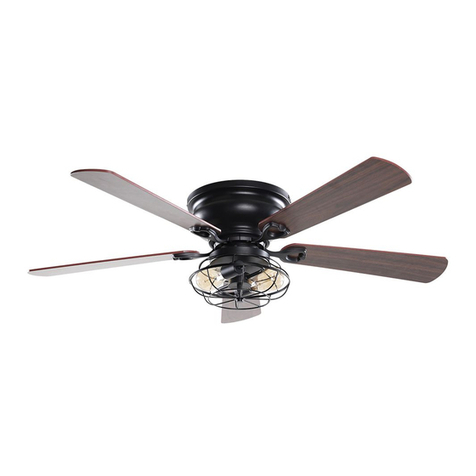
Parrot Uncle
Parrot Uncle F6233 Installation & operating instructions

Honeywell
Honeywell Myers Park 51861 user manual

silavent
silavent SVC6 installation instructions

BLAUBERG
BLAUBERG BLABDUCTO user manual
